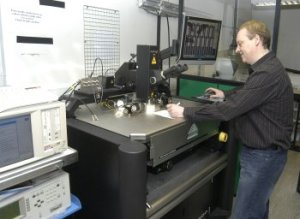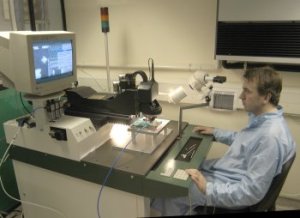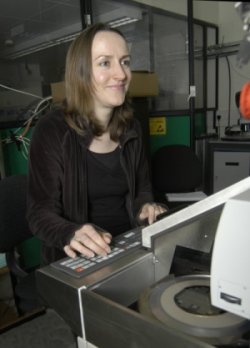Laboratory Facilities
Laboratory Facilities
 The PPE group has successfully grown its laboratory space over the last three years by a factor of two, having received an additional 170 m2 of laboratory space adjacent to the present accommodation of the group. The University-granted SRIF2 funding of £410k has been used to equip the laboratory with a state-of-the-art backend test facility comprising a 300 mm wafer probe station complemented by fully automatic wire-bonding and wafer dicing equipment.
The PPE group has successfully grown its laboratory space over the last three years by a factor of two, having received an additional 170 m2 of laboratory space adjacent to the present accommodation of the group. The University-granted SRIF2 funding of £410k has been used to equip the laboratory with a state-of-the-art backend test facility comprising a 300 mm wafer probe station complemented by fully automatic wire-bonding and wafer dicing equipment.
This wire-bonding facility produced half of the UK production of forward modules for the SCT of ATLAS. The wafer probe is the only one of its kind in a UK University and ideally places the group to participate in the development of technologies for the next generation of particle physics experiments where there is currently a switch to a 0.13 micron technology. This is the last technology node that will be available on 200 mm wafers.
We share clean room facilities with the IGR group (30 m2 at class 1000 with Class 100 work benches).
The James Watt Nanofabrication Centre in the Department of Electronics and Electrical Engineering gives us the ability to tailor-make our own semiconductor detectors and devices through a fully equipped nano fabrication facility in 750 m2 of dedicated clean rooms. Certain PPE group members have been trained in the use of this equipment. We are therefore exceptionally well placed to develop innovative ideas from concept.
Cascade Microtech S300 12" Semiconductor Probestation
Cascade Microtech S300 12" Semiconductor Probestation
 This probe station is one of two of its kind in the UK. It is fitted with ‘AttoGuard’ technology which permits the measurement of extremely low leakage currents over the entire wafer surface. The prober is fully automatic and has been interfaced to a Keithley semiconductor parameter analyser with preamplifiers capable of current measurement in the femtoamp range, an Aglient LCR meter, and a switching matrix.
This probe station is one of two of its kind in the UK. It is fitted with ‘AttoGuard’ technology which permits the measurement of extremely low leakage currents over the entire wafer surface. The prober is fully automatic and has been interfaced to a Keithley semiconductor parameter analyser with preamplifiers capable of current measurement in the femtoamp range, an Aglient LCR meter, and a switching matrix.
Hesse and Knipps Bondjet 710 wire bonder
Hesse and Knipps Bondjet 710 wire bonder
 Our wire bonder is a fully automatic wedge-to-wedge wire bonder. It has a comprehensive suite of parameter measurement and analysis tools that records the strength and bondquality for each bond as it is laid down by the machine. This machine was used to bond three hundred modules during the ATLAS SCT production in Glasgow, laying down over 1.5 Million bonds in the process. It is also used for bonding devices for our other research projects and for external work.
Our wire bonder is a fully automatic wedge-to-wedge wire bonder. It has a comprehensive suite of parameter measurement and analysis tools that records the strength and bondquality for each bond as it is laid down by the machine. This machine was used to bond three hundred modules during the ATLAS SCT production in Glasgow, laying down over 1.5 Million bonds in the process. It is also used for bonding devices for our other research projects and for external work.
Fabrication Facilities
Fabrication Facilities
The Particle Physics Experiment (PPE) Group utilises micro and nano-fabrication technology to make many of their devices. Some of the fabrication work is carried out using the equipment located in the James Watt Nanofabrication Centre (JWNC). Devices are patterned using either a Karl Suss MA6 mask aligner, an EBPG 5HR 100, or a VB6 UHR EWF electron beam lithography tool. Some of the other pieces of equipment used include Dry Etch machines, Plassys metallisation equipment, Hitachi scanning electron microscopes, and Veeco metrology equipment.
Semiconductor characterisation facilities
Semiconductor characterisation facilities
The Group has a range of experiments to characterise semiconductor detectors and their response to ionizing radiation. These include:
- Keithley current/voltage source-measure units
- Agilent LCR meters
- a manual probe station
- two environmental chambers
- a freezer with a dry atmosphere
- several dark boxes
To measure the response of detectors the group has: an Ortec MCA for alpha or gamma irradiation; for high energy Sr-90 electrons an Ortec-based single channel trigger MIP set-up, and a multi-channel trigger LHCb Beetle amplifier-based MIP set-up; a laser source for laser scanning of patterned devices; a dental x-ray source, and a high intensity x-ray source with diffractometer. There is also a visible to UV light source for spectral measurements.
Disco DAD 321 Automatic Dicing Saw
Disco DAD 321 Automatic Dicing Saw
 This is a fully programmable dicing saw for the precision dicing of wafers up to 100 mm in diameter. It is used to dice objects from silicon, GaAs and glass for different research projects which the group is involved in.
This is a fully programmable dicing saw for the precision dicing of wafers up to 100 mm in diameter. It is used to dice objects from silicon, GaAs and glass for different research projects which the group is involved in.
Optical Surface Profiler
Optical Surface Profiler
The Wyko NT1100 Optical surface profiler from Veeco is a metrology system using non-contact interferometry to measure surface features. The system has two measurement modes:
- Vertical shift interferometry (VSI): this uses white light and is used for measuring features in the range 140 nm to several mm
- Phase shift interferometry (PSI): utilising a filtered light source and a piezo electric phase shift
Small features can be measured, from ~1 to 140 nm. The system has an automated stitching stage for large area coverage. Measurements can be made on any reflective surface.
TM1000 SEM
TM1000 SEM
The Hitachi TM1000 table top SEM is a self contained SEM. It is able to take samples of sizes 50 mm in diameter and up to a max of 20 mm height. The system has a pump-down time of less than 5 minutes, with a maximum magnification of x10k giving a resolution of ~30 nm. It also features a facility to image insulating surfaces using an air micro-bleed to prevent charge build-up.
Olympus Nomarski DIC microscope
Olympus Nomarski DIC microscope
This microscope has the choice of reflected or transmitted light observation with a maximum magnification of 100x. The microscope has a range of features including:
- Darkfield observation Polariser and analyser for stress observation
- Differential image contrast (DIC) measurement
- UV source for fluorescence of biological samples
- Olympus CELL DAQ software running off of a DP-70 12.5 Mpix digital camera
HAAS VM-2SE Milling Centre
HAAS VM-2SE Milling Centre
The Group uses a HAAS VM-2SE fully automated 5-axis vertical milling centre for manufacturing large mechanical structures and small complex parts. The maximum table size is 760x 610x 610 mm. The mill has high speed machining capabilities with the 4th and 5th axis fully integrated and controlled through dedicated post processor software. The tool is capable of milling to better than 10 micron precision over the entire machining volume.
For further information on any of the equipment described above, please contact Richard Bates or Liam Cunnigham

